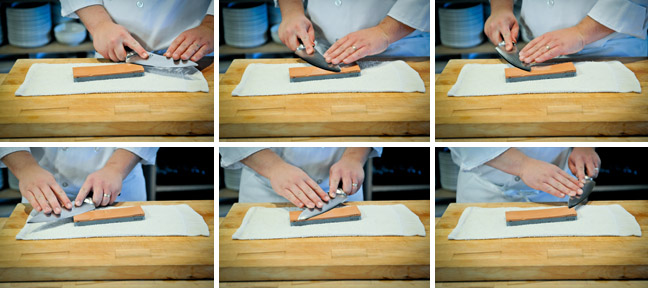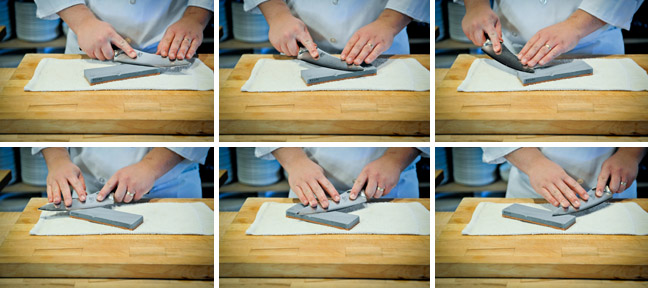When sharpening a Japanese knife, it is important that you always use a water stone, unless otherwise instructed by the manufacturer. Using an oilstone can actually dull a Japanese blade, or even completely ruin it.
Before you start, make sure that you soak your water stone in water for at least 5-10 minutes prior to sharpening. The water will act as lubrication, allowing the particles that are taken off the blade during the sharpening process to easily leave the stone.
After your stone is thoroughly soaked, wet a kitchen towel, squeeze out the excess moisture, and lay it flat on your work surface. Place the water stone on top of the towel. This will help prevent the stone from slipping during the sharpening process.

You will notice, on the stone, that one side is course and the other is fine. The course side is your shaping stone, and the finer side is your honing stone.
To begin, place the bottom of your blade at the top end of your shaping stone - at a 16°-18° angle. To find the proper angle, place the blade of you knife directly on top of your stone as if you were going to try and cut the stone in half. This would be a 90° angle. Half that, and you have a 45° angle, and half of that would be a 22.5° angle, which is the perfect angle for a German knife. Now just take off a couple more degrees, and you’ll have your 18°-16° angle. Another way to think of it is pretending that you are trying to shave an extremely thin layer off the top of the stone.

With one fluid movement, starting from the bolster of the knife, run your blade along the shaping stone, pretending that you’re shaving off a thin layer of the stone. Notice how the left hand is applying gentle pressure at the tip of the knife. This hand is helping to maintain the angle at which the knife is being sharpened, and is allowing even pressure to be applied to the blade.

Repeat this process for 10-30 strokes (depending on how dull your knife is) on one side of the blade, and then repeat the same process on the opposite side. When sharpening the opposite side of your knife, it’s easiest to switch up your grip. For example, if you were holding the handle of your knife in your right hand, now you will be holding it in your left as shown above.

Once you have completed 10-30 strokes on each side of the blade, using the shaping portion of your stone, flip the water stone over to the finer, honing side (shown on previous page). Again do 10-30 strokes on both sides of the blade. If the blade starts to “grind” at anytime during the sharpening process, simply re-wet the stone by dunking it into a container of cold water.
To finish the sharpening process, run you knife on your honing steel at the same angle which you were sharpening your blade (in this case 16°-18°). Make sure that you are using the proper steel for your knife as discussed in the previous section on honing. For more information on recommended sharpening stones and steels for both German and Japanese knives, see the end of this section.
If your knife is still not as sharp as you would like it to be, repeat the entire process, starting with the shaping stone, and then moving to the honing stone and finally the honing steel. Make sure that you are constantly concentrating on maintaining your desired angle while sharpening your knife.
Related Resources
There are 10 Comments

@ GreenBake, I think having
@ GreenBake,
I think having the knowledge and at least understanding how the knife sharpening process is done is what's important. I've found that most home cooks will usually need their knife sharpened every 6-12 months. A lot of manufactures even offer to sharpen you knife to its original factory edge for free, the only problem is that you have to pack up your knife, ship it off and it usually has a 4-5 week turnaround. This might be OK for a home cook with a back-up knife, but I can't go a single day without my knives, they're how I pay my bills (and shoot all these videos).
The water stone used in this video was purchased for $50 at my local restaurant supply store, which means you can order it online for much cheaper. If you want to bring your knife to a local sharpener, they can usually do it on the spot, while you wait, for about $10 or $20 a knife.
Stone versus steel?
When do you use the stone versus just a sharpening steel? I recently purchased a Shun 7" Wide Santoku knife and was told to use the sharpening steel 3-4 times on each side every time I use it.

@ GreenBake is right on. I'll
@ GreenBake is right on. I'll use my honing steel right before I use my knife, and sometimes during the use of my knife (like when doing a lot of butchery for the restaurant). Under a microscope, the edge on all knives looks like that of a serrated bread knife. When all the teeth are aligned your knife is nice and sharp.
After lots of cutting is done, the teeth start to bend backwards, making your knife less sharp. Running your knife at the proper angle along a honing steel will bring these "teeth" back into alignment. After lots of use, bending and realigning, there comes a point when the blade is so mangled on a microscopic level that you have to take off the edge and sharpen (as demonstrated in this video).
waterstone grade?
What grades/grit do you recommend for a waterstone?

It really depends on personal
It really depends on personal preference. Ideally you would have a low grit for shaping (500), medium grit for sharpening (1000) and fine grit for honing or polishing (6000). The stone that I use in the video is a 600/1000, but I've since moved on to using a 1000/6000 for my every day knife sharpening, and 500 grit for shaping and thinning the blade.

The knife I use in this video
The knife I use in this video is an 8" Ken Onion Shun.
